Phase Change Materials in Transparent Building Envelopes: A Strengths, Weakness, Opportunities and Threats (SWOT) Analysis
Abstract
1. Introduction
1.1. Background
1.2. Aim of the Paper
2. Literature Review at a Glance
- -
- in the “Geographical distribution of the studies” chart, each bar expresses the number of studies conducted for each country;
- -
- in the “Climatic distribution of the studies”, “PCM typology”, “Type of analysis” and “Type of experimental characterisation” charts, each bar expresses, in percentage, the number of studies which considered the feature described in each row;
- -
- the “PCM encapsulation” pie chart reports, in percentage, the distribution of the analysed articles, according to the typology of the containers.
- the geographical distribution of the studies, which also provides an indication of the climatic conditions of the study;
- the technologies had predominantly been characterised in outdoor test cells (57%) [14,15,17,18,19,20,21,22,24,25,26,27,29,31,35] and through laboratory analysis (53%) [12,13,17,20,23,32,33,34,35,36,37,38,39,40,41,42], while some other studies had been carried out by coupling a modelling activity with an experimental activity (37%) [12,13,14,16,21,23,29,30,32,34,37,40];
- the parameters investigated for the performance characterization of PCM transparent building envelope components have been found to be related above all to thermal performance (70%) [13,14,16,17,18,19,20,21,22,23,24,25,26,27,29,30,31,36,37,41,42] and lighting performance (43%) [12,20,21,22,31,32,33,34,35,38,39,40,41], while 30% of the studies evaluated energy performance [15,21,22,23,25,28,31,37,38];
3. PCMs in Transparent Building Envelopes: A Technology Classification
- (1)
- in the glazing, in order to directly enhance the heat capacity and thermal inertia of fenestration;
- (2)
- in the shutters, where they act as an energy buffer, and can be positioned either inside or outside a traditional window;
- (3)
- in façade systems, to interact with other insulating materials and solar control devices in a multilayer technology.
- Technology number 0, basic glazing technology: integration of the PCM in DGU glazing;
- Technology number 1, advanced glazing technology: integration of the PCM in TGU glazing;
- Technology number 2, shutter technology: integration of the PCM in the shutter;
- Technology number 3, façade system: integration of the PCM in the façade.
4. SWOT Analysis
4.1. Strenghts and Weaknesses of PCM Glazing Systems
- the basic glazing technology (Section 4.1.1);
- the advanced glazing technologies: integration of the PCM in TGU glazing (Section 4.1.2);
- the shutter technology: integration of the PCM in the shutter (Section 4.1.3);
- the façade system: integration of the PCM in the façade (Section 4.1.4).
4.1.1. Basic Technology: Integration of the PCM in DGU Glazing
- to exploit the time shift of the cooling load—a well-designed project will ensure that the external temperature will start to decline before total melting of the enclosed PCM [15];
- to collect and store solar energy at a building scale—a reduction in the “mismatch” between the heating demand and the availability of solar radiation during winter time-[15];
- a “mitigation” of the internal glass surface temperatures, which leads to an improvement in the thermal comfort [14].
4.1.2. Advanced Technology: Integration of the PCM in TGU Glazing
- the location of the PCM compared to the position of the glazing;
- the PCM layer thickness;
- the interaction of the PCM with insulating materials;
- the interaction of the PCM with solar control devices in order to control daylighting.
- solar gain reduction during daytime;
- heat storage within the paraffin layer;
- IR radiation absorption;
- heat flux peak shift;
- better control of the PCM melting process using a TT layer.
4.1.3. Shutter Technology: Integration of PCMs in Shutters
- heat gain reduction;
- internal surface temperature reduction;
- thermal comfort enhancement;
- peak cooling load reduction;
- glare risk reduction;
- thermal inertia enhancement and heat loss reduction in winter.
4.1.4. Façade System: Integration of the PCM in Façades
4.2. Threats and Opportunities of PCM Glazing Systems
5. Conclusions and Suggestions for Future Research Activities
Acknowledgments
Author Contributions
Conflicts of Interest
References
- Baetens, R.; Jelle, B.P.; Gustavsen, A. Phase change materials for building applications: A state-of-the-art review. Energy Build. 2010, 42, 1361–1368. [Google Scholar] [CrossRef]
- Pomianowski, M.; Heiselberg, P.; Zhang, Y. Review of thermal energy storage technologies based on PCM application in buildings. Energy Build. 2013, 67, 56–69. [Google Scholar] [CrossRef]
- Sharma, A.; Tyagi, V.V.; Chen, C.R.; Buddhi, D. Review on thermal energy storage with phase change materials and applications. Renew. Sustain. Energy Rev. 2009, 13, 318–345. [Google Scholar] [CrossRef]
- Wang, X.; Zhang, Y.; Xiao, W.; Zeng, R.; Zhang, Q.; Di, H. Review on thermal performance of phase change energy storage building envelope. Sci. Bull. 2009, 54, 920–928. [Google Scholar] [CrossRef]
- Zhou, D.; Zhao, C.Y.; Tian, Y. Review on thermal energy storage with phase change materials (PCMs) in building applications. Appl. Energy 2012, 92, 593–605. [Google Scholar] [CrossRef]
- Khudhair, A.M.; Farid, M.M. A review on energy conservation in building applications with thermal storage by latent heat using phase change materials. Energy Convers. Manag. 2004, 45, 263–275. [Google Scholar] [CrossRef]
- Tatsidjodoung, P.; Le Pierrès, N.; Luo, L. A review of potential materials for thermal energy storage in building applications. Renew. Sustain. Energy Rev. 2013, 18, 327–349. [Google Scholar] [CrossRef]
- Hasnain, S.M. Review on sustainable thermal energy storage technologies, Part I: Heat storage materials and techniques. Energy Convers. Manag. 1998, 39, 1127–1138. [Google Scholar] [CrossRef]
- Silva, T.; Vicente, R.; Rodrigues, F. Literature review on the use of phase change materials in glazing and shading solutions. Renew. Sustain. Energy Rev. 2016, 53, 515–535. [Google Scholar] [CrossRef]
- Fokaides, P.A.; Kylili, A.; Kalogirou, S.A. Phase change materials (PCMs) integrated into transparent building elements: A review. Mater. Renew. Sustain. Energy 2015, 4. [Google Scholar] [CrossRef]
- Rezaei, S.D.; Shannigrahi, S.; Ramakrishna, S. A review of conventional, advanced, and smart glazing technologies and materials for improving indoor environment. Sol. Energy Mater. Sol. Cells 2017, 159, 26–51. [Google Scholar] [CrossRef]
- Manz, H.; Egolf, P.; Suter, P.; Goetzberger, A. TIM–PCM external wall system for solar space heating and daylighting. Sol. Energy 1997, 61, 369–379. [Google Scholar] [CrossRef]
- Li, S.; Zhong, K.; Zhou, Y.; Zhang, X. Comparative study on the dynamic heat transfer characteristics of PCM-filled glass window and hollow glass window. Energy Build. 2014, 85, 483–492. [Google Scholar] [CrossRef]
- Goia, F.; Perino, M.; Serra, V. Improving thermal comfort conditions by means of PCM glazing systems. Energy Build. 2013, 60, 442–452. [Google Scholar] [CrossRef]
- Goia, F.; Perino, M.; Serra, V. Experimental analysis of the energy performance of a full-scale PCM glazing prototype. Sol. Energy 2014, 100, 217–233. [Google Scholar] [CrossRef]
- Weinläder, H.; Beck, A.; Fricke, J. PCM-facade-panel for daylighting and room heating. Sol. Energy 2005, 78, 177–186. [Google Scholar] [CrossRef]
- Weinlaeder, H.; Koerner, W.; Heidenfelder, M. Monitoring results of an interior sun protection system with integrated latent heat storage. Energy Build. 2011, 43, 2468–2475. [Google Scholar] [CrossRef]
- Silva, T.; Vicente, R.; Rodrigues, F.; Samagaio, A.; Cardoso, C. Development of a window shutter with phase change materials: Full scale outdoor experimental approach. Energy Build. 2015, 88, 110–121. [Google Scholar] [CrossRef]
- Komerska, A.; Bianco, L.; Serra, V.; Fantucci, S.; Rosiński, M. Experimental analysis of an external dynamic solar shading integrating PCMs: First results. Energy Procedia 2015, 78, 3452–3457. [Google Scholar] [CrossRef]
- Berthou, Y.; Biwole, P.H.; Achard, P.; Sallée, H.; Tantot-Neirac, M.; Jay, F. Full scale experimentation on a new translucent passive solar wall combining silica aerogels and phase change materials. Sol. Energy 2015, 115, 733–742. [Google Scholar] [CrossRef]
- Liu, C.; Wu, Y.; Li, D.; Zhou, Y.; Wang, Z.; Liu, X. Effect of PCM thickness and melting temperature on thermal performance of double glazing units. J. Build. Eng. 2017, 11, 87–95. [Google Scholar] [CrossRef]
- Bianco, L.; Cascone, Y.; Goia, F.; Perino, M.; Serra, V. Responsive glazing systems: Characterisation methods and winter performance. Sol. Energy 2017, 155, 372–387. [Google Scholar] [CrossRef]
- Zhong, K.; Li, S.; Sun, G.; Li, S.; Zhang, X. Simulation study on dynamic heat transfer performance of PCM-filled glass window with different thermophysical parameters of phase change material. Energy Build. 2015, 106, 87–95. [Google Scholar] [CrossRef]
- Jain, L.; Sharma, S.D. Phase Change Materials for Day Lighting and Glazed Insulation in Buildings. J. Eng. Sci. Technol. 2009, 4, 322–327. [Google Scholar]
- Goia, F.; Bianco, L.; Cascone, Y.; Perino, M.; Serra, V. Experimental Analysis of an Advanced Dynamic Glazing Prototype Integrating PCM and Thermotropic Layers. Energy Procedia 2014, 48, 1272–1281. [Google Scholar] [CrossRef]
- Silva, T.; Vicente, R.; Rodrigues, F.; Samagaio, A.; Cardoso, C. Performance of a window shutter with phase change material under summer Mediterranean climate conditions. Appl. Therm. Eng. 2015, 84, 246–256. [Google Scholar] [CrossRef]
- Li, S.; Sun, G.; Zou, K.; Zhang, X. Experimental research on the dynamic thermal performance of a novel triple-pane building window filled with PCM. Sustain. Cities Soc. 2016, 27, 15–22. [Google Scholar] [CrossRef]
- Bianco, L.; Vigna, I.; Serra, V. Energy assessment of a novel dynamic PCMs based solar shading: Results from an experimental campaign. Energy Build. 2017, 150, 608–624. [Google Scholar] [CrossRef]
- Silva, T.; Vicente, R.; Amaral, C.; Figueiredo, A. Thermal performance of a window shutter containing PCM: Numerical validation and experimental analysis. Appl. Energy 2016, 179, 64–84. [Google Scholar] [CrossRef]
- Durakovic, B.; Torlak, M. Experimental and numerical study of a PCM window model as a thermal energy storage unit. Int. J. Low-Carbon Technol. 2016. [Google Scholar] [CrossRef]
- Bianco, L.; Cascone, Y.; Goia, F.; Perino, M.; Serra, V. Responsive glazing systems: Characterisation methods, summer performance and implications on thermal comfort. Sol. Energy 2017, 158, 819–836. [Google Scholar] [CrossRef]
- Gowreesunker, B.L.; Stankovic, S.B.; Tassou, S.A.; Kyriacou, P.A. Experimental and numerical investigations of the optical and thermal aspects of a PCM-glazed unit. Energy Build. 2013, 61, 239–249. [Google Scholar] [CrossRef]
- Goia, F.; Zinzi, M.; Carnielo, E.; Serra, V. Characterization of the optical properties of a PCM glazing system. Energy Procedia 2012, 30, 428–437. [Google Scholar] [CrossRef]
- Li, D.; Zheng, Y.; Li, Z.; Qi, H. Optical properties of a liquid paraffin-filled double glazing unit. Energy Build. 2015, 108, 381–386. [Google Scholar] [CrossRef]
- Goia, F.; Zinzi, M.; Carnielo, E.; Serra, V. Spectral and angular solar properties of a PCM-filled double glazing unit. Energy Build. 2015, 87, 302–312. [Google Scholar] [CrossRef]
- Grynning, S.; Goia, F.; Time, B. Dynamic Thermal Performance of a PCM Window System: Characterization Using Large Scale Measurements. Energy Procedia 2015, 78, 85–90. [Google Scholar] [CrossRef]
- Frontini, F.; Pfafferott, J.; Herkel, S.; Schwarz, D. Building simulation study of a residential double-row house with seasonal PCM-translucent façade. In Proceedings of the CleanTech for Sustainable Buildings: From Nano to Urban Scale, Lausanne, Switzerland, 14–16 September 2011; pp. 99–104. [Google Scholar]
- Ismail, K.A.; Henriquez, J. Thermally effective windows with moving phase change material curtains. Appl. Therm. Eng. 2001, 21, 1909–1923. [Google Scholar] [CrossRef]
- Ismail, K.A.; Henrı́quez, J. Parametric study on composite and PCM glass systems. Energy Convers. Manag. 2002, 43, 973–993. [Google Scholar] [CrossRef]
- Ismail, K.A.; Henriquez, J.R.; Te, D.D.E. PCM Glazing Systems. Int. J. Energy Res. 1997, 21, 1241–1255. [Google Scholar] [CrossRef]
- Liu, C.; Wu, Y.; Zhu, Y.; Li, D.; Ma, L. Experimental investigation of optical and thermal performance of a PCM-glazed unit for building applications. Energy Build. 2018, 158, 794–800. [Google Scholar] [CrossRef]
- Grynning, S.; Goia, F.; Rognvik, E.; Time, B. Possibilities for characterization of a PCM window system using large scale measurements. Int. J. Sustain. Built Environ. 2013, 2, 56–64. [Google Scholar] [CrossRef]
- Li, S.; Zhou, Y.; Zhong, K.; Zhang, X.; Jin, X. Thermal analysis of PCM-filled glass windows in hot summer and cold winter area. Int. J. Low-Carbon Technol. 2013, 1–8. [Google Scholar] [CrossRef]
- Li, D.; Ma, T.; Liu, C.; Zheng, Y.; Wang, Z.; Liu, X. Thermal performance of a PCM-filled double glazing unit with different optical properties of phase change material. Energy Build. 2016, 119, 143–152. [Google Scholar] [CrossRef]
- Li, D.; Li, Z.; Zheng, Y.; Liu, C.; Hussein, A.K.; Liu, X. Thermal performance of a PCM-filled double-glazing unit with different thermophysical parameters of PCM. Sol. Energy 2016, 133, 207–220. [Google Scholar] [CrossRef]
- Liu, C.; Zhou, Y.; Li, D.; Meng, F.; Zheng, Y.; Liu, X. Numerical analysis on thermal performance of a PCM-filled double glazing roof. Energy Build. 2016. [Google Scholar] [CrossRef]
- Liu, C.; Wu, Y.; Li, D.; Ma, T.; Hussein, A.K.; Zhou, Y. Investigation of thermal and optical performance of a phase change material–filled double-glazing unit. J. Build. Phys. 2017, 174425911770873. [Google Scholar] [CrossRef]
- Bionda, D.; Kräuchi, P.; Plüss, I.; Schröcker, M. Simulation of the thermal performance of translucent phase change materials and whole-building energy implications. In Proceedings of the 10th Conference on Advanced Building Skins, Bern, Switzerland, 3–4 November 2015; pp. 673–680. [Google Scholar]
- Goia, F. Thermo-physical behaviour and energy performance assessment of PCM glazing system configurations: A numerical analysis. Front. Archit. Res. 2012, 1, 341–347. [Google Scholar] [CrossRef]
- Wang, Q.; Zhao, C.Y. Parametric investigations of using a PCM curtain for energy efficient buildings. Energy Build. 2015, 94, 33–42. [Google Scholar] [CrossRef]
- Soares, N.; Samagaio, A.; Vicente, R.; Costa, J. Numerical simulation of a PCM shutter for buildings space heating during the winter. In Proceedings of the World Renewable Energy Congress 2011 (WREC2011), Linköping, Sweden, 8–13 May 2011; pp. 1797–1804. [Google Scholar]
- Alawadhi, E.M. Using phase change materials in window shutter to reduce the solar heat gain. Energy Build. 2012, 47, 421–429. [Google Scholar] [CrossRef]
- Iennarella, S.; Serra, V.; Lo, V.R.M. A novel concept of a responsive transparent façade module: Optimization of energy performance through parametric design. Energy Procedia 2015, 78, 358–363. [Google Scholar] [CrossRef]
- Elarga, H.; Goia, F.; Zarrella, A.; Dal Monte, A.; Benini, E. Thermal and electrical performance of an integrated PV-PCM system in double skin façades: A numerical study. Sol. Energy 2016, 136, 112–124. [Google Scholar] [CrossRef]
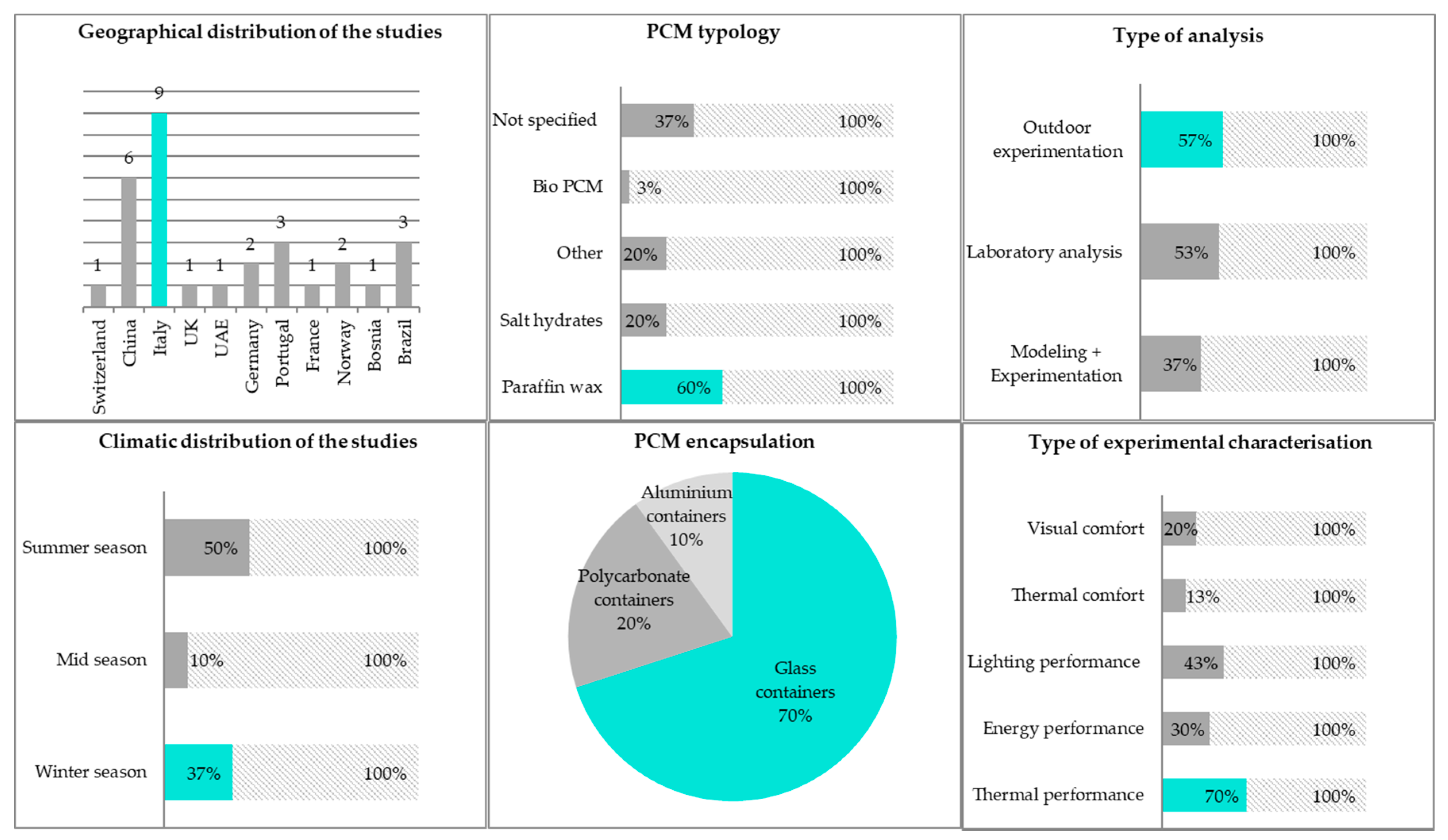
| Technology | Sketch | Description | Concept |
|---|---|---|---|
| 0_ basic glazing technology: integration of the PCM in DGU glazing | |||
| 0 | 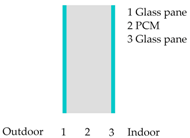 | Integration of the PCM in a double glazing unit (DGU + PCM) | Solar control modulation and thermal inertia improvement |
| 1_ advanced glazing technology: integration of the PCM in TGU glazing | |||
| 1 |  | Integration of the PCM in a triple glazing unit (TGU + PCM) | Solar control modulation, thermal resistance and thermal inertia improvement |
| 1a | 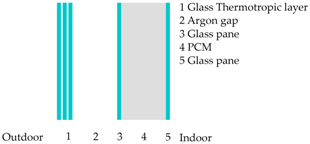 | Integration of the PCM in a triple glazing unit with a control system (TGU + PCM + TT) | Better control of the PCM charge phase |
| 2_ shutter technology: integration of the PCM in a shutter | |||
| 2a |  | PCM external shutter | Time shift of incoming peak loads; glare reduction |
| 2b |  | PCM internal shutter | Solar energy storage in winter; internal window surface temperature reduction in summer |
| 3_ façade system: integration of the PCM in a façade | |||
| 3a | 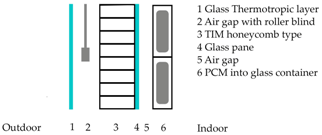 | TIM + PCM | Selective optical transmittance of solar radiation; improvement in the thermal inertia of the glazing system |
| 3b |  | Aerogel + PCM | Superinsulation and heat storage, increase in the U value |
| 3c |  | Prismatic solar reflector | Light control, heat storage and improvement in the thermal inertia |
| 3d | 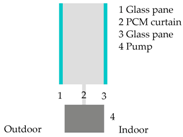 | Double glass with PCM curtain controlled by an electric pump | Light control, heat gain control |
| 0_ Basic Glazing Technology: Integration of the PCM in DGU Glazing S: Strengths, W: Weaknesses, O: Opportunities, T: Threats | ||||||
|---|---|---|---|---|---|---|
| Ref. | PCM | Aims | S | W | O | T |
| Technology 0 Durakovic et al., 2017 [30] | Paraffin wax | Impact of PCM on the thermal performance of windows | Improvement in the thermal performance (lower interior surface temperature and overheating delay) and reduction in the building energy demand | Instantaneous jump in the heat gain once the PCM has melted completely. | ||
| Technology 0 Goia et al., 2013 [14] | Paraffin wax | Evaluation of the thermal comfort performance during different seasons | Shading and buffering effects of the PCM improve the indoor thermal conditions and prevent glare effects | No significant comfort improvement on cloudy days (low incident solar irradiation); overheating risk during summer | Few commercial PCM glazing on the market, and limited quantification of their real advantages in terms of energy efficiency and indoor environmental comfort. | |
| Technology 0 Goia et al, 2014 [15] | Paraffin wax | Thermal benefits of a PCM glazed unit compared with traditional double glass | Reduction in the total daily energy gains. Smooth shift of solar gains in summer. | Partial phase change process in winter, decrease in the solar free gains; overheating risk during summer; required integration of the system with indoor air temperature control strategies | The transition temperatures of PCM can be chosen freely over a wide range of values and thus a relatively high degree of tuning is assured to suit different conditions; Integration of PCM in transparent elements allows daylighting to be exploited while preserving privacy (when PCM is in solid phase) | The integration of PCM in a traditional DGU could determine an increase in the price of the final product (impact on the production costs of the glazed unit) |
| Technology 0 Gowreesunker et al., 2013 [32] | Paraffin wax | Characterization of the optical and thermal aspects of a PCM glazed unit compared with a reference unit | Improvement in the thermal mass of the transparent envelope | The transmittance spectra are unstable during rapid changes in temperature or the phase of the PCM; changeability of the visual aspects | Change in transparency of PCM as a design issue | Some default modelling of phase change in some simulation tools not based on the effective-heat capacity method may lead to inaccurate results |
| Technology 0 Liu et al., 2017 [21,41] | Effects of PCM thickness and melting temperature on the thermal performance of double glazing units | During winter, the thickness of the PCM layer of a DGU PCM system positively influences the performances of the system as a result of an increase in the interior temperature, and of a decrease in the total transmitted energy and transmitted solar energy | Weak optical performance of the technology filled with PCM | |||
| Technology 0 Zhong et al., 2015 [26] | Paraffin wax | Effects of the thermophysical PCM parameters on the dynamic heat transfer characteristics of a PCM window | Shifts in the peak load of an air conditioning system; heat transfer reduction during a sunny summer; load shift effect and thermal insulation effect of PCM glazing improves with the increasing latent heat of fusion. | Slight increase in the solar heat gain of the system compared to the reference system, in the presence of low solar radiation; heat transfer increase on rainy summer days | High costs and unsatisfactory annual energy saving effects of other commercially available tested transparent technologies (thermochromic window, electrochromic glass, window with semi-conductor solar cells and low-E film) | |
| 1_ Advanced Glazing Technology: Integration of the PCM in TGU Glazing S: Strengths, W: Weaknesses, O: Opportunities, T: Threats | ||||||
|---|---|---|---|---|---|---|
| Ref. | PCM | Aims | S | W | O | T |
| Technology 1 Li et al., 2016 [27] | Paraffin wax MG29 | Evaluation of the thermal performance and energy saving potential of a TGU + PCM during summer days | On sunny days, PCM in the outer chamber of a system effectively reduced peak temperatures on the interior surface and incoming heat, compared to a reference system | On rainy days, the system is unable to satisfactorily reduce the peak heat flux and delay the peak temperature on the inner surface | Possibility of adjusting and shifting the peak load of an air conditioning system, and of reducing its energy consumption | |
| Technology 1a Goia et al., 2014, Bianco et al., 2017 [22,25,31] | Paraffin wax | Evaluation of the effect of the position of a PCM layer (inner-outer cavity of the TGU) on the thermo-physical performance of the technology system | An TT layer prevented the complete melting of PCM in an inner cavity; reduction in the solar gain and peak indoor surface temperature during daytime | Complete exploitation of the latent heat of fusion of PCM in an outer cavity with a consequent increase in the transmitted irradiance; in the case of high solar irradiation, PCM in the outermost cavity negatively affects the thermo-physical behaviour of a system | Further investigation of the behaviour of a system inserting PCM with different transition temperatures; enhancement solar energy use and reduction of the time mismatch between solar energy availability and heating/cooling energy demand | Limited effect of the thermotropic layer considering the small variations in the optical properties |
| 2_ Shutter Technology: Integration of the PCM in the Shutters S: Strengths, W: Weaknesses, O: Opportunities, T: Threats | ||||||
|---|---|---|---|---|---|---|
| Ref. | PCM | Aims | S | W | O | T |
| Technology 2a A. Komerska et al., 2015 [19] | Paraffin wax | Evaluation of the thermal performance of a polycarbonate shutter containing PCM in a mid-season (solid phase) | Reduction in the total daily solar heat gains and in the internal surface temperature; preservation of high illuminance level. Improvements in the thermal resistance of the shutter and window of the system | Absence of a melting process during the whole measurement period; during cloudy days, performance decrease in the system; negative effect of a solar heat gain reduction in winter | ||
| Technology 2a Bianco et al., 2017 [28] | Paraffin wax, Salt hydrates, bio PCM | Experimental analysis in an outdoor test cell to evaluate the energy performance of the technology and verify the influence of the colour of the polycarbonate panels and the behaviour of different PCM typologies | Good potentiality of the technology to reduce the cooling daily energy compared to the reference system. Reduction in the internal surface temperature of the glazing with a PCM shutter, compared to reference system. Improvement in the thermal inertia of the dynamic window with a time peak shift of the heat fluxes. | Decrease in the performance of the total heat flux reduction of the PCM systems for higher sol-air temperatures than 26 °C, compared to the reference; discontinuity in appearance during the melting phase of the PCM; | Future research developments to make the system more adaptive and better performing during summer, and extending its use to winter and intermediate seasons may require the coupling of different panels (colours, thicknesses) filled with PCM with different melting temperatures and typologies; optimization strategies of light and solar transmittance can be obtained by fluidizing the materials in the panel using slurry PCM | Limited scientific evidence in literature in relation to the durability of bio PCMs; sealing problem of the material in polycarbonate; the observed discontinuity in appearance of PCMs could limit architectural applications of transparent components containing PCM |
| Technology 2b Weinläder et al., 2005 [16] | Paraffin wax, Salt hydrates | Effect of variations in the PCM typology on the thermal—comfort performance | Low heat loss in winter; reduction in the peak cooling loads in summer; thermal comfort enhancement | Leakage of the containers, inhomogeneous appearance; overheating risk in summer; limited visual contact with the environment | Homogeneous visual performance investigations by means of a concealing measure, e.g., screen-printed glazing; investigation of the thermal comfort performance | |
| Technology 2b Weinlaeder et al., 2011 [17] | Salt hydrates | Effect of PCM integrated with the blinds of a polycarbonate shutter on the thermo-physical performance of office buildings | Reduction in the surface temperatures of the inner side of the shutter; g-value of the system reduced during the melting process; reduction in the cooling loads and improvement in the thermal comfort | Incomplete regeneration of the PCM during the night; daylighting reduction; overheating risks during the night; ventilation system integrated to dissipate stored heat | Steady-state calculations—such as those that are usually given in standards —are often not sufficient to describe PCM systems | |
| Technology 2b Silva et al., 2015, 2016 [18,26,29] | Paraffin wax | Effect of PCM integrated with the blinds of an aluminium shutter on the thermo-physical performance | Reduction in the maximum indoor peak temperature; decreased heat flux | Fast and complete melting of the PCM determines indoor discomfort conditions; introduction of an active ventilation system to improve the PCM charging and discharging processes | Thermal inertia improvement using PCM in large glazing areas, which currently dominate architectural design | Numerical model requires simplifications (a change in volume between solid and liquid phases is not considered) |
| 3_Façade System: Integration of the PCM in the Façade S: Strengths, W: Weaknesses, O: Opportunities, T: Threats | ||||||
|---|---|---|---|---|---|---|
| Ref. | PCM | Aims | S | W | O | T |
| Technology 3a Manz et al, 1997 [12] | Salt hydrates | Characterization of a novel external wall (PCM + TIM) by means of optical experiments on a PCM, experiments on a prototype and numerical simulations | Reduction in the energy losses | Backscattering of the solar radiation in the solid state, which leads to an increase in the solar gains and light transmittance; safety—mechanical destruction of the glass container | Investigation of the aesthetic/architectural/comfort values of a transparent wall; testing the durability and reliability of the system; | |
| Technology 3b Berthou et al., 2015 [20] | Eutectics of fatty acids | Evaluation of the passive solar behaviour by combining super insulation, heat storage and daylighting | Improvement in the U-value, good daylighting performance when PCM is in a liquid state | Overheating risk in summer; no melting process of PCM in winter and no solidification process in summer | Architectural value of a transparent passive solar wall; investigation of acoustic properties of the system (high-sound absorptivity and lower-than-air velocity of sound propagation) | |
| Technology 3c Grynning et al., 2013–2015 [36,42] | Salt hydrates | Definition of the thermal behaviour and conditions needed for thermal mass activation | Thermal mass activation of a PCM, even for cold climates | No uniform melting process; long-time interval between periodic phase change processes should be addressed to ensure the complete achievement of the cycle | ||
| Technology 3d Ismail et al., 1997, 2001 [38,40] | Coloured PCM | Effect of variations in the PCM thickness on the performance parameters (U-value and g-value) | Solar radiation filtering; good performance of coloured PCMs—green and blue | Presence of an electric pump | Investigation of the thermal/ visual comfort performance of coloured PCMs | Insufficient number of available properties to simulate the behaviour of PCMs |
| Technology 3d Ismail et al., 2002 [39] | Glycol mixture—blue and green coloured PCMs | Effect of variations in the PCM thickness and in the colour on the thermal-optical parameters | Reduction in transmittance using blue and green PCMs | Aesthetic/architectural value of the coloured PCM; investigation of the thermal comfort performance | One-dimensional formulation of the model neglected the effects of the extremities of the panel | |
| Strengths |
|
| Weaknesses |
|
| Opportunities |
|
| Threats |
|
© 2018 by the authors. Licensee MDPI, Basel, Switzerland. This article is an open access article distributed under the terms and conditions of the Creative Commons Attribution (CC BY) license (http://creativecommons.org/licenses/by/4.0/).
Share and Cite
Vigna, I.; Bianco, L.; Goia, F.; Serra, V. Phase Change Materials in Transparent Building Envelopes: A Strengths, Weakness, Opportunities and Threats (SWOT) Analysis. Energies 2018, 11, 111. https://doi.org/10.3390/en11010111
Vigna I, Bianco L, Goia F, Serra V. Phase Change Materials in Transparent Building Envelopes: A Strengths, Weakness, Opportunities and Threats (SWOT) Analysis. Energies. 2018; 11(1):111. https://doi.org/10.3390/en11010111
Chicago/Turabian StyleVigna, Ilaria, Lorenza Bianco, Francesco Goia, and Valentina Serra. 2018. "Phase Change Materials in Transparent Building Envelopes: A Strengths, Weakness, Opportunities and Threats (SWOT) Analysis" Energies 11, no. 1: 111. https://doi.org/10.3390/en11010111
APA StyleVigna, I., Bianco, L., Goia, F., & Serra, V. (2018). Phase Change Materials in Transparent Building Envelopes: A Strengths, Weakness, Opportunities and Threats (SWOT) Analysis. Energies, 11(1), 111. https://doi.org/10.3390/en11010111






